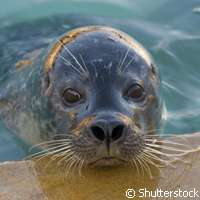If you ever thought that murky waters would stop seals in their (hunting) tracks, think again. Harbour seals (Phoca vitulina) extend their vibration-sensitive whiskers to find food when their vision is obstructed. But can these mammals differentiate objects that pass them? Scientists from the University of Rostock in Germany shed new light on the ability of harbour seals to distinguish between the wakes (the trails of water disturbance) generated by objects that differ in both size and shape. The findings of the study are presented in the Journal of Experimental Biology.
The Rostock scientists had already identified the seals' ability to perceive and follow fish wakes, around half a minute after the prey passes. In this latest study, they found that harbour seals use only their whiskers to make distinctions in wakes produced by different objects.
The researchers evaluated a harbour seal called Henry. They tested the seal's ability to distinguish between the wakes of differently sized paddles. Blindfolding Henry's eyes and covering his ears, the investigators swept a paddle through a big box in the seal's enclosure. After an interval of just three seconds, Henry was allowed to enter the area, where he was tested.
Already trained to press a target outside the enclosure when he recognised the wake of a standard paddle, Henry was also trained to press a different target when he recognised the wake of a bigger or smaller paddle. Henry, according to the researchers, could differentiate between paddles that had a tiny difference between them, as little as 2.8 centimetres in width. Following this, they tested which aspects of the wake Henry detected.
'We randomised the speeds of the paddles so that the maximum flow velocity wasn't a distinguishing cue for the widest paddles, but the structure of the wake had to be recognised by the seal and he could do that too, but with slightly less accuracy,' says Professor Wolf Hanke of the University of Rostock.
Henry was also tested on his ability to distinguish between the wakes of triangular, cylindrical, flat and undulating paddles. His responses were spot on when he distinguished between cylindrical and flat, flat and undulating, and cylindrical and undulating paddles.
Henry didn't pass muster when it came to distinguishing between the triangular paddle from the cylindrical or undulating shapes, though.
Using digital particle image velocimetry to measure Henry's successful attempts at distinguishing between the wakes of passing objects that vary in size and shapes, Professor Hanke says it is not easy to determine which 'part of the wake serves the animal most and which aided only a little'.
The Rostock researcher plans to test the seal's responses to single vortices in order to identify the wake components that could give a fish's size and shape away. The seal's hunting efficiency would be hugely boosted if it could differentiate between various differently sized fish, particularly thin ones which force them to waste a lot of energy in order to reach their target.
More information: Wieskotten, S., et al. (2011) Hydrodynamic discrimination of wakes caused by objects of different size or shape in a harbor seal (Phoca vitulina). J Exp Biol 214: 1922-1930. DOI:10.1242/jeb.053926
Provided by CORDIS






















